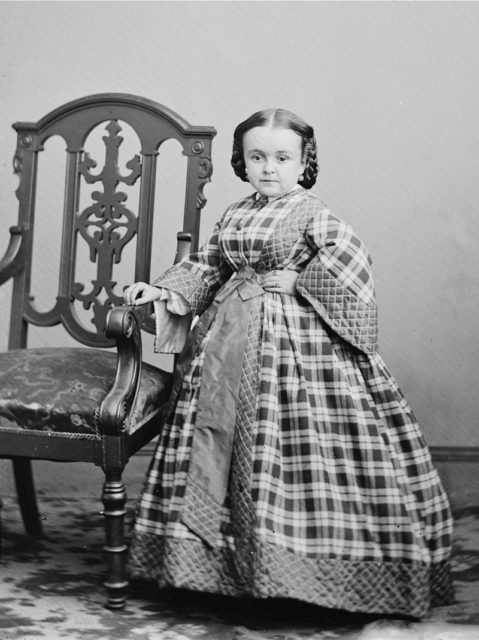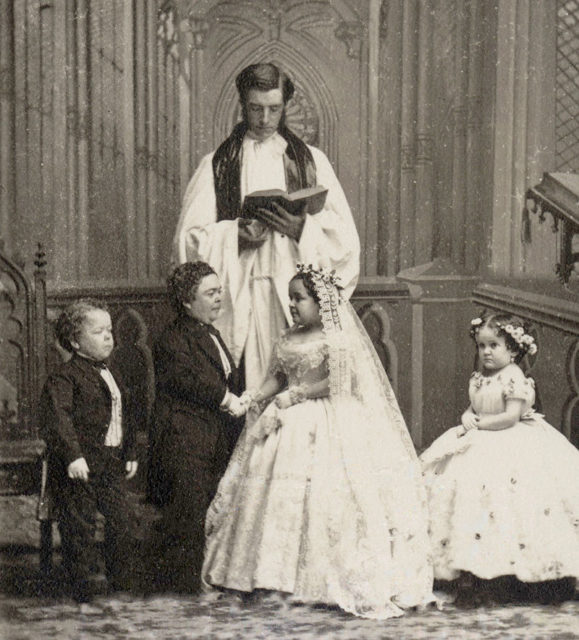One of the preferred forms of entertainment throughout the Victorian period was the exhibition of so-called freaks, the monstrosities or marvels of nature. In order to be marketable and profitable, the displayed “freaks” had to be to the public’s taste.
In order to attract more visitors, the managers of the freak shows told tales about oddities with extraordinary talents who, supposedly, could do normal things despite their disabilities. A famous example of this type of person was the glamorous Lavinia Warren.
Lavinia Warren was born to a respectable family in New England in 1841. As a baby, she weighed nine pounds and seemed perfectly healthy. However, as soon as her parents noticed that she had stopped growing as a toddler, they suspected something was wrong. Soon after, the doctors diagnosed tiny Lavinia with dwarfism, and thankfully, her parents didn’t treat her any differently during her young years–she was expected to study, do chores, and work hard. The only exception they made when considering her condition was in building a step-stool so that she could reach the kitchen table when cooking. Furthermore, they encouraged her to support herself and so at 16, she began working as a teacher.
Lavinia’s turning point happened on a showboat in Mississippi owned by her cousin, who talked her into spending her summer break on the boat to participate in the program called the Museum of Living Wonders. “The Lilliputian Queen,” as she was named for artistic purposes, could dance, sing, and chat with the public. Sometimes she shared the stage with Silvia Hardy, a giantess from Maine with whom Lavinia became close friends. The audience was captured by Lavinia’s charisma and looked forward to her performance, so by the end of the summer she was a star.

In 1862, the impresario and showman P. T. Barnum, who’d established a museum for oddities, came to meet her. He thought that Lavinia would fit perfectly into his museum–she sang, danced, spoke graciously and charmingly with her fans. Also, she was single. Lavinia was a lovable girl, and many of her co-workers fell for her charm, including Commodore Nutt, who was seven years her senior and, reportedly, head over heels in love with her, while she was completely indifferent.
However, the person who made the right move at the right time and beat the rest of the admirers was Charles Stratton, publicly known as Tom Thumb, and one of Barnum’s most famous colleagues. He fell in love with Lavinia and plotted to win her over. He took Barnum aside and asked him to play the role of matchmaker for him and Lavinia, and in return, he suggested providing him with a publication of their wedding. Barnum considered it a top deal as he only needed to give “fatherly advice” to Lavinia about Thumb’s qualities, presenting him as a well-situated husband and a good catch.
Thumb proposed, and Lavinia said yes. The wedding ceremony was quite glamorous and made intentionally intriguing for the public eye. It took place in New York’s fashionable Grace Church on Broadway and the reception was held in the extravagant Metropolitan Hotel. Lavinia’s wedding dress was custom-made, designed by Madame Demorest, one of the most sought after fashion designers at the time. The diminutive-sized wedding gown was put on display for weeks prior to the wedding to draw the public’s interest.

On the day of the wedding, a massive crowd flocked to attend the reception. There were around 10,000 attendees and some of them paid a $50 admission fee. Barnum succeeded in turning the wedding into an event of the year. The newlyweds stood on top of a grand piano and received the guests.
The event was big in the press and reporters from the Saturday Evening Post and New York Times were invited by Barnum. They devoted an entire column to the event, describing it in detail and listed the wedding presents: Tiffany’s gems, a miniature billiards table, and a carriage from Queen Victoria were all given a special mention. “No one need be surprised that two little matters should create such a tremendous hullabaloo, such a furor of excitement, such an intensity of interest,” wrote the New York Times.
The story of the newlywed miniature duo was a welcome distraction from the actual Civil War, so the public loved it. It was the first time in three years that the war didn’t cover the front pages. The public was especially focused on the petite new bride, to whom, after the wedding, Barnum offered $5,000 (today, $116,000) to perform in his museum during the following months. He was certain that she wouldn’t reject him as little people didn’t have many work options in the 19th century, but Lavinia, a rising star with many prospects, replied, “As I do not intend giving a public exhibition until I have appeared before the Courts of Europe, and perhaps not even then, I must respectfully decline your offer.”

Even President Lincoln was eager to meet the couple, so he invited them to the White House. Lavinia’s reaction to Lincoln’s reception was quite antagonistic due to Lincoln’s joking about their height difference.
Lavinia enjoyed the lifestyle of high society, cultivating lavish spending habits for expensive designer items and clothes that she loved to wear while socializing with presidents and other socially eminent figures. Tom had his part of the cake as well, living comfortably with her for the next 20 years. Their professional engagements included part-time performing at Barnum’s American Museum in New York or touring with shows.
Read another story from us: The heartbreaking story of Joseph Merrick, the real “Elephant Man”
After Tom’s death in 1883, Lavinia’s poor money sense left her almost penniless, however, two years later she met another pair of performing little people from Italy–“Count” Primo Magri and his brother “Baron” Giuseppe. Lavinia married the Count, they formed an independent opera company and went on to perform all over.
In 1919, Lavinia died, and upon her request was buried alongside Charles Stratton, her first husband, in Bridgeport, Connecticut. The gravestone of the two bears Stratton’s name with a life-size statue of himself, while Lavinia is simply marked as “His Wife.”
